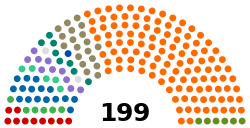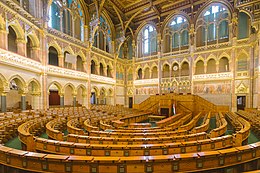National Assembly (Hungary)
Diet Országgyűlés | |
|---|---|
| Coat of arms or logo | |
| Type | |
| Type | |
| Leadership | |
Csaba Hende, Fidesz (for legislation) Sándor Lezsák, Fidesz István Jakab, Fidesz János Latorcai, KDNP Lajos Oláh, DK Dóra Dúró, MHM | |
Leader of largest political group | |
Leader of 2nd largest political group | |
| Structure | |
| Seats | 199 |
 | |
Political groups | Government (134)
Supported by (1) Opposition (63) |
| Elections | |
| Partially parallel, partially compensatory voting: 106 FPTP seats, 93 PR seats with 5% electoral threshold (D'Hondt method) | |
Last election | 3 April 2022 |
Next election | On or before 2026 |
| Meeting place | |
 | |
| Hungarian Parliament Building Lajos Kossuth Square 1 Budapest, H-1055 Hungary | |
| Website | |
| parlament.hu/national-assembly | |

 |
|---|
The National Assembly (Hungarian: Országgyűlés, lit. 'Country Assembly' [ˈorsaːɡɟyːleːʃ]) is the parliament of Hungary. The unicameral body consists of 199 (386 between 1990 and 2014) members elected to four-year terms. Election of members is done using a semi-proportional representation: a mixed-member majoritarian representation with partial compensation via transfer votes and mixed single vote; involving single-member districts and one list vote; parties must win at least 5% of the popular vote in order to gain list seats. The Assembly includes 25 standing committees to debate and report on introduced bills and to supervise the activities of the ministers. The Constitutional Court of Hungary has the right to challenge legislation on the grounds of constitutionality.
Under communist rule, the National Assembly existed as the supreme organ of state power as the sole branch of government in Hungary, and per the principle of unified power, all state organs were subservient to it. Since 1902, the assembly has met in the Hungarian Parliament Building in Budapest.
The current members are the members of the National Assembly of Hungary (2022–2026).
History
[edit]The Diet of Hungary[1] (Hungarian: Országgyűlés) was a legislative institution in the medieval kingdom of Hungary from the 1290s,[2] and in its successor states, Royal Hungary and the Habsburg kingdom of Hungary throughout the Early Modern period. The name of the legislative body was originally "Parlamentum" during the Middle Ages, the "Diet" expression gained mostly in the Early Modern period.[3] It convened at regular intervals with interruptions during the period of 1527 to 1918, and again until 1946.
The articles of the 1790 diet set out that the diet should meet at least once every 3 years, but, since the diet was called by the Habsburg monarchy, this promise was not kept on several occasions thereafter. As a result of the Austro-Hungarian Compromise, it was reconstituted in 1867.
The Latin term Natio Hungarica ("Hungarian nation") was used to designate the political elite which had participation in the diet, consisting of the nobility, the Catholic clergy, and a few enfranchised burghers,[4][5] regardless of language or ethnicity.[6] Natio Hungarica was a geographic, institutional and juridico-political category.[7]
The democratic character of the Hungarian parliament was reestablished with the fall of the Iron Curtain and the end of the communist dictatorship in 1989. Today's parliament is still called the Országgyűlés, as in royal times, but is called the 'National Assembly' to distance itself from the historical royal diet.
Latest general election
[edit]| 7:00 | 9:00 | 11:00 | 13:00 | 15:00 | 17:00 | 18:30 | Overall |
|---|---|---|---|---|---|---|---|
| 1.82% | 10.31% | 25.77% | 40.01% | 52.75% | 62.92% | 67.80% | 70.21% |
 | |||||||||
|---|---|---|---|---|---|---|---|---|---|
| Party | Party-list | Constituency | Total seats | +/– | |||||
| Votes | % | Seats | Votes | % | Seats | ||||
| Fidesz-KDNP | 3,060,706 | 54.13 | 48 | 2,823,419 | 52.80 | 87 | 135 | +2 | |
| United for Hungary | 1,947,331 | 34.44 | 38 | 1,983,708 | 37.09 | 19 | 57 | –8 | |
| Our Homeland Movement | 332,487 | 5.88 | 6 | 307,064 | 5.74 | 0 | 6 | New | |
| Hungarian Two-Tailed Dog Party | 185,052 | 3.27 | 0 | 126,648 | 2.37 | 0 | 0 | 0 | |
| Solution Movement | 58,929 | 1.04 | 0 | 64,341 | 1.20 | 0 | 0 | New | |
| Party of Normal Life | 39,720 | 0.70 | 0 | 31,495 | 0.59 | 0 | 0 | New | |
| National Self-Government of Germans | 24,630 | 0.44 | 1 | 1 | 0 | ||||
| National Self-Government of Croats | 1,760 | 0.03 | 0 | 0 | 0 | ||||
| National Self-Government of Slovaks | 1,208 | 0.02 | 0 | 0 | 0 | ||||
| National Self-Government of Rusyns | 645 | 0.01 | 0 | 0 | 0 | ||||
| National Self-Government of Romanians | 526 | 0.01 | 0 | 0 | 0 | ||||
| National Self-Government of Serbs | 418 | 0.01 | 0 | 0 | 0 | ||||
| National Self-Government of Ukrainians | 396 | 0.01 | 0 | 0 | 0 | ||||
| National Self-Government of Poles | 281 | 0.00 | 0 | 0 | 0 | ||||
| National Self-Government of Greeks | 232 | 0.00 | 0 | 0 | 0 | ||||
| National Self-Government of Slovenes | 219 | 0.00 | 0 | 0 | 0 | ||||
| National Self-Government of Armenians | 163 | 0.00 | 0 | 0 | 0 | ||||
| National Self-Government of Bulgarians | 157 | 0.00 | 0 | 0 | 0 | ||||
| Leftist Alliance | 8,678 | 0.16 | 0 | 0 | New | ||||
| True Democratic Party | 989 | 0.02 | 0 | 0 | New | ||||
| Civic Response | 521 | 0.01 | 0 | 0 | New | ||||
| Our Party – IMA | 326 | 0.01 | 0 | 0 | New | ||||
| Party of Greens | 208 | 0.00 | 0 | 0 | New | ||||
| Democratic Organisation of the Hungarian Poor and Workers | 177 | 0.00 | 0 | 0 | New | ||||
| Hungarian Liberal Party | 152 | 0.00 | 0 | 0 | 0 | ||||
| Total | 5,654,860 | 100.00 | 93 | 5,347,726 | 100.00 | 106 | 199 | 0 | |
| Valid votes | 5,654,860 | 99.00 | |||||||
| Invalid/blank votes | 57,065 | 1.00 | |||||||
| Total votes | 5,711,925 | 100.00 | |||||||
| Registered voters/turnout | 8,215,304 | 69.53 | |||||||
| Source: National Electoral Commission,[8] National Electoral Commission | |||||||||
Result by constituency
[edit]Party list results by county and in the diaspora
[edit]| County[9] | Fidesz-KDNP | United for Hungary | Our Homeland | MKKP | MM | NÉP | Turnout [10] | ||
|---|---|---|---|---|---|---|---|---|---|
| Bács-Kiskun | 57.25 | 29.66 | 7.58 | 3.08 | 1.01 | 0.81 | 67.5% | ||
| Baranya | 49.67 | 36.08 | 5.93 | 3.54 | 0.93 | 0.86 | 67.5% | ||
| Békés | 52.81 | 34.36 | 7.64 | 2.62 | 0.92 | 0.89 | 66.4% | ||
| Borsod-Abaúj-Zemplén | 54.38 | 34.29 | 6.89 | 2.31 | 0.99 | 0.78 | 64.7% | ||
| Budapest | 40.84 | 47.84 | 4.11 | 5.19 | 1.26 | 0.53 | 75.5% | ||
| Csongrád-Csanád | 47.44 | 39.69 | 7.34 | 3.61 | 1.10 | 0.72 | 70.5% | ||
| Fejér | 53.55 | 33.80 | 6.62 | 3.52 | 1.15 | 0.76 | 71.5% | ||
| Győr-Moson-Sopron | 57.07 | 30.83 | 6.21 | 3.28 | 1.33 | 0.72 | 73.7% | ||
| Hajdú-Bihar | 57.88 | 30.87 | 6.60 | 2.69 | 1.02 | 0.83 | 66.1% | ||
| Heves | 54.98 | 33.37 | 7.31 | 2.50 | 0.97 | 0.74 | 69.0% | ||
| Jász-Nagykun-Szolnok | 55.58 | 33.02 | 7.15 | 2.45 | 0.95 | 0.82 | 65.9% | ||
| Komárom-Esztergom | 50.53 | 36.32 | 6.72 | 3.39 | 1.11 | 0.95 | 69.3% | ||
| Nógrád | 59.00 | 29.27 | 7.66 | 2.15 | 0.80 | 0.68 | 66.9% | ||
| Pest | 50.88 | 36.44 | 5.81 | 4.05 | 1.25 | 0.66 | 72.9% | ||
| Somogy | 56.33 | 33.48 | 5.97 | 2.22 | 1.02 | 0.66 | 68.2% | ||
| Szabolcs-Szatmár-Bereg | 61.66 | 29.04 | 5.59 | 1.64 | 0.91 | 0.80 | 65.4% | ||
| Tolna | 58.95 | 28.49 | 6.67 | 2.46 | 0.90 | 0.81 | 68.8% | ||
| Vas | 59.94 | 29.55 | 5.59 | 2.89 | 0.89 | 0.72 | 74.8% | ||
| Veszprém | 52.57 | 34.44 | 6.88 | 3.39 | 1.00 | 0.76 | 71.8% | ||
| Zala | 56.72 | 31.98 | 6.63 | 2.68 | 0.95 | 0.94 | 71.6% | ||
| Total in Hungary | 52.45 | 36.15 | 6.15 | 3.42 | 1.10 | 0.73 | 70.21% | ||
| Diaspora | 93.89 | 4.12 | 1.06 | 0.61 | 0.10 | 0.22 | |||
| Total | 54.13 | 34.44 | 5.88 | 3.27 | 1.04 | 0.70 | 69.59% | ||
Speakers of the National Assembly of Hungary
[edit]Historical composition of the National Assembly since 1990
[edit]
| ||||||||||||||||||||
| 1990–1994 |
| |||||||||||||||||||
| 1994–1998 |
| |||||||||||||||||||
| 1998–2002 |
| |||||||||||||||||||
| 2002–2006 |
| |||||||||||||||||||
| 2006–2010 |
| |||||||||||||||||||
| 2010–2014 |
| |||||||||||||||||||
| 2014–2018 |
| |||||||||||||||||||
| 2018–2022 |
| |||||||||||||||||||
| 2022–2026 |
| |||||||||||||||||||
Notes
[edit]References
[edit]- ^ András Gergely, Gábor Máthé: The Hungarian state: thousand years in Europe (published in 2000)
- ^ Elemér Hantos: The Magna Carta Of The English And Of The Hungarian Constitution (1904)
- ^ Cecil Marcus Knatchbull-Hugessen Brabourne (4th Baron): The political evolution of the Hungarian nation: (Volume I. in 1908)
- ^ John M. Merriman, J. M. Winter, Europe 1789 to 1914: encyclopedia of the age of industry and empire, Charles Scribner's Sons, 2006, p. 140, ISBN 978-0-684-31359-7
- ^ Tadayuki Hayashi, Hiroshi Fukuda, Regions in Central and Eastern Europe: past and present, Slavic Research Center, Hokkaido University, 2007, p. 158, ISBN 978-4-938637-43-9
- ^ Katerina Zacharia, Hellenisms: culture, identity, and ethnicity from antiquity to modernity, Ashgate Publishing, Ltd., 2008, p. 237 ISBN 978-0-7546-6525-0
- ^ "Transylvania – The Roots of Ethnic Conflict". Hungarianhistory.com. Retrieved 15 April 2018.
- ^ a b "Nemzeti Választási Iroda - Országgyűlési Választás 2022" [National Electoral Commission - Election of National Assembly Representatives 2022] (in Hungarian). 16 April 2022. Archived from the original on 22 April 2022.
- ^ "Részvételi arány az országgyűlési választásokon". ksh.hu.
- ^ "Országgyűlési képviselők választása 2022 - országos listás szavazás eredménye". valasztas.hu.
External links
[edit]- (in English) Official website
- (in Hungarian) Official website
